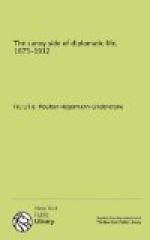There is on the farm a large building in which the famous Parmesan cheese is made. We were shown the entire process from the milking of the cows down to the great wheels (which look like millstones) and the completed cheese. Milking is a process with which you are, perhaps, not familiar. It is done with the help of a maiden and a three-legged stool, while the cow goes on chewing the worn-out cud of her last meal, occasionally giving a Cenci-like glance of approbation.
But I won’t tell you about that; I will let you in the secrets of Parmesan-cheese making, so that when you are eating it grated on macaroni you may know what an old stager you have to do with. The milk is put in great vats just as it comes from the mesdames les vaches; there it remains, occasionally turned around, not churned, with a wooden paddle, until it becomes a solid substance.
When it is hard enough to handle it is put into large round wooden forms and allowed to remain untouched—for how long do you think? One year! Then they put it under the oil regime—that is to say, olive-oil is poured through the cheese at regular intervals until the rind is as black and thick as leather. In four years it is ready to be sold. Each cheese weighs several hundred pounds, is a foot thick, and is as big as a cart-wheel. We eat it every day for luncheon and dinner. I like it so much better, fresh and straight from the farm (if anything four years old can be called fresh), than when stale and grated.
ROME, 1888.
My dear Aunt,—Leo XIII.’s jubilee has been the means of bringing the world to Rome. Every day during these last weeks we have watched the carts passing our house piled with huge cases which contained the presents destined for the Holy Father.
The streets are filled with pilgrims from everywhere. One cannot look in any direction without seeing processions of nuns, priests, and monks of all nations and denominations, from the dingy brown Franciscans, the Capucines with their white mantles displaying their bare legs, to the youthful disciples of the Propaganda in their brilliant scarlet cassocks, not to speak of the forestiere armed with their red Baedekers, who are doing Rome and at the same time doing the Pope’s Jubilee.
Everything and every one on the way to the Vatican.
We went to see the gifts, which are exposed in many rooms on the ground floor of the Vatican. There was an enormous quantity of things of every description, useful, ornamental, and superfluous. The windmills, bells, every sort of vehicle, rowboats, sailboats, and every modern invention had been put out in the Vatican gardens.
You can have no idea of the incredible amount of slippers sent (thousands of them); church vetements by the hundreds, embroidered by millions of women who must have worked themselves blind; the most exquisite articles of needlework, incrusted with pearls and precious stones which have probably cost a mint of money.




